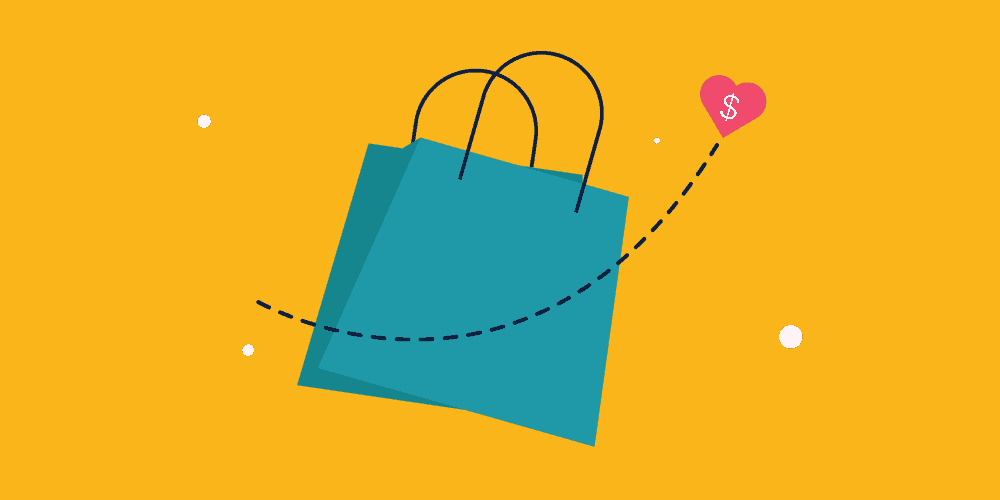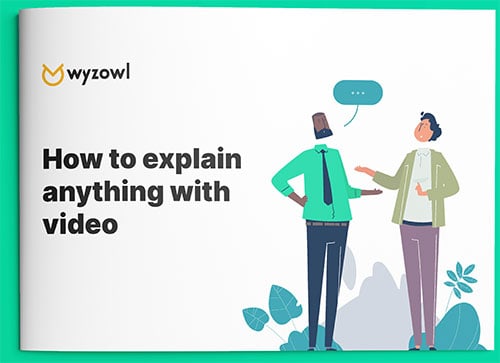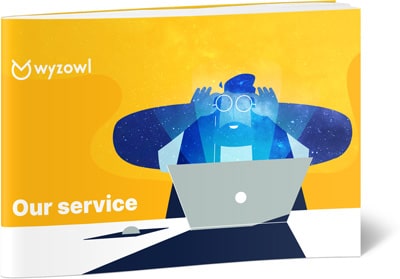Last updated on 20th November 2023
Want to know how to gain customer trust and confidence, leading to more loyal customers? Follow these 13 actionable methods and you’ll be well on your way to gaining and retaining a loyal fanbase.
1. Tell your story
Telling your story is a crucial part of building a brand. It shapes how your audience views you and allows them to look beyond the products and understand where you’re coming from.
If you can convey your brand’s history, expertise and awards, you’re en route to developing a brand that people can identify with. One that’s loved for its approach, values and authenticity.
Have you noticed that when you feel a kindred spirit with someone you’re naturally drawn to them?
It’s exactly the same in business.
All-natural skincare brand Burt’s Bees are master storytellers. Their #BringBackTheBees campaign saw them pledge to plant 5,000 bee-friendly wildflowers with the British Beekeepers Association for every limited edition lip balm purchased.
They highlighted the bees’ plight by setting up a fake florists plagued by disappearing flowers (much to their customers’ surprise!) to spread the message that, “a world without bees is a world without flowers.” With more than two million views for this video alone, they had their finger on the pulse of public opinion with this video.
If you can style out your own story like this, you might just earn the emotional (and financial!) investment of your customers.
2. Be honest and transparent
If you want to gain your customers’ trust, there are no shortcuts; you’re going to have to earn it. How do you do that? Well, a great starting point is to be open and transparent about your products and what potential customers can expect of you as a company.
Forget about making exaggerated claims about how you’ve invented the best thing since sliced bread. Modern customers are wise to gimmicks and hype. Just be straightforward.
Give your customers all the information they need – including clear pricing and even limitations – to help them make an informed decision. The more clued up a customer feels, the more likely they are to give you repeat business.
To say that McDonald’s has occasionally suffered from an image problem is an understatement. Recognising the impact that years of damning headlines were doing to their ability to maintain trust in the brand, the burger barons set out to dispel the myths surrounding their food production methods.
In their bid to educate the doubters and turn the tide of opinion, their charm offensive has seen them face down common criticisms and demonstrate responsible practices, like only using sustainable fish and free-range eggs.
Meeting their critics head-on, they’ve gone some way to diffuse some of the guilt some customers might have felt about visiting the golden arches.
Honesty is disarming. Try it and see what a difference it makes to your customer trust levels.
3. Know your target audience
Market research was seen as a bit of a gimmick not that long ago. But it’s more important than ever in an age where consumers crave a personalised experience rather than a one-size-fits-all approach.
Conducting thorough research into your customers’ needs, their common issues and pain points will help you to develop tailored solutions and messages that resonate with them on a very individual basis.
If you can demonstrate a deep understanding of their needs and provide a service that not only solves their problems but delivers added value, then your customers are far more likely to trust you.
In 1950, long-running American teen magazine Seventeen developed what must be one of the earliest examples of a “buyer persona” with the creation of Teena (get it?!) – a fictional character based on survey data and used to peddle advertising space.
Teena, so the blurb said, was “too tall, too plump, too shy” but found solace from her “favorite magazine for the tip-off on the clothes she wears, the food she eats, the lipstick she wields.”
Because of this deep understanding of their audience (and their insecurities) Seventeen were able to write articles that spoke directly to their readership. Given that they’re still going strong, it clearly works for them!
Get to know your audience as well as Seventeen to give your sales and marketing activities laser-like focus.
4. Share positive reviews
What do employers, landlords and consumers all share in common? They all demand references to find out whether the people they’re dealing with are trustworthy and reliable.
When was the last time you made a restaurant reservation without first checking online reviews on TripAdvisor or Yelp? Word of mouth recommendations are important.
We trust the experiences of others over the claims of a company. Online reviews can help a customer to build up a strong and immediate impression of a brand’s goods and their customer service credentials.
According to our own research, 9 out of 10 people say they trust what a customer says about a business more than what that business says about itself and 95% of people say that reviews – whether positive, or negative – influence their purchasing decisions. Clearly, reviews are now a huge part of our decision-making processes.
On average, a customer needs to read 10 reviews before they trust a company. So leverage the power of recommendations by displaying unedited positive reviews prominently on your website, sharing positive feedback across your social media channels, and responding to positive reviews (and negative, for that matter!) quickly and professionally to build a healthy reservoir of trust.
Google My Business is the fastest-growing reviews site and offers the added bonus of better local rankings for high scoring businesses. There are countless other channels you can use too, including Facebook, Feefo and Trustpilot to name but a few.
Shout about your success to secure the social proof you need to persuade new and existing customers to trust your business. UK-based swim school Puddle Ducks do this brilliantly on their testimonial page with glowing quotes from their customers.
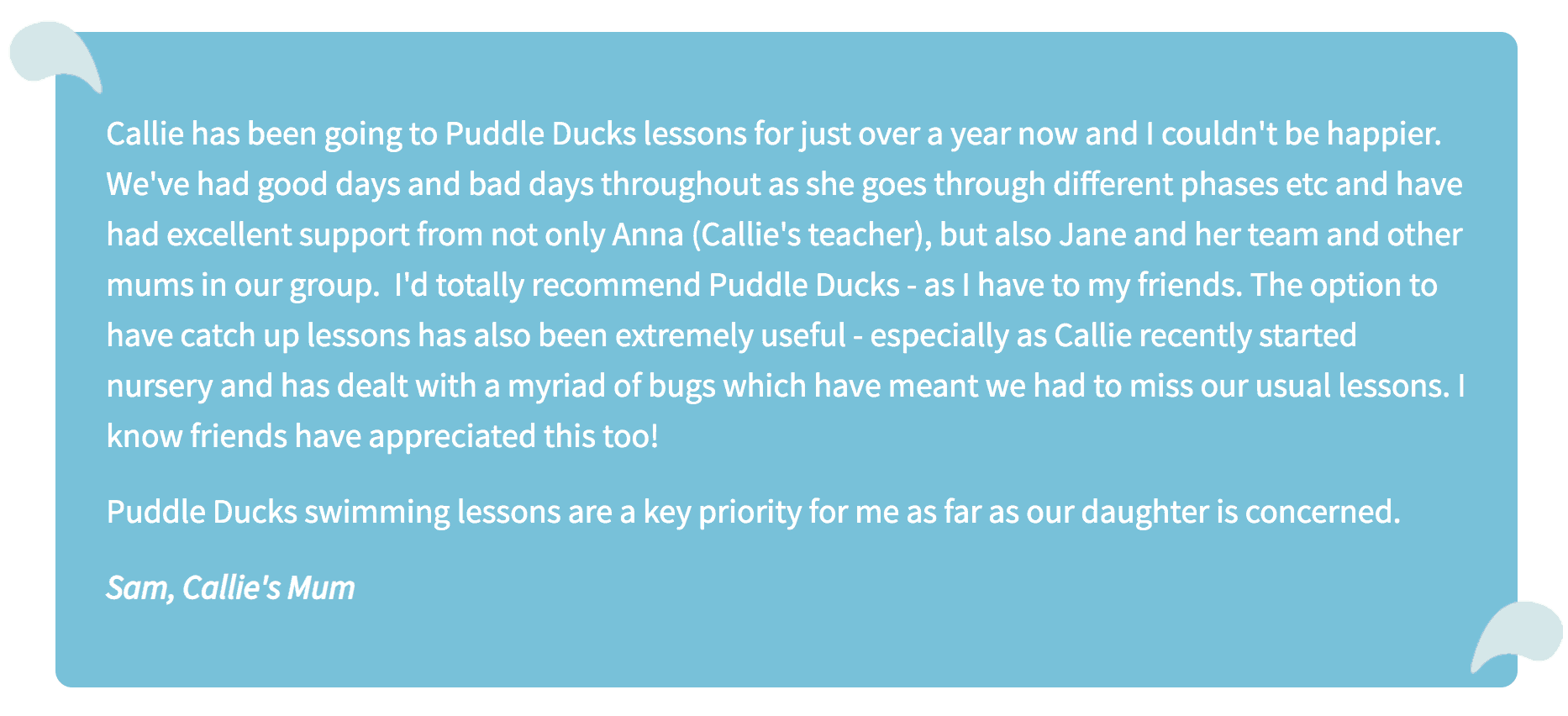
They’ve even included certified reviews that are pulled directly from Google and Facebook for added emphasis.

Don’t be ashamed to ask and encourage your happy customers to leave reviews, as well. They play too big a part in the decision-making process to get bashful about it!
5. Create and share video testimonials
Taking the power of word-of-mouth a step further, video testimonials can be a powerful medium for demonstrating the worth of your products and the prowess of your service.
Brand ambassadors who are willing to go on record and wax lyrical about their experiences with your company are a much more compelling and engaging proposition than if you tried to convey the same message yourselves.
Consumers trust unbiased opinions more than corporate messaging, so a testimonial video can be a great onboarding tool to persuade customers to buy into your business.
As a video production company, Wyzowl uses video testimonials to demonstrate the value we bring to our clients.
Randy Frisch, COO and Co-Founder of Uberflip, is just one of our many satisfied customers who has returned to use our services multiple times.
“I often say the best way to determine a great partner is your willingness to work with them again,” says Randy. “We’ve done this time and time again with Wyzowl and I urge others to do the same!”
Having honest and organic brand advocacy, like Randy’s, provides a crucial narrative for building trust – especially for new customers.
Don’t be afraid to approach your customers for a testimonial. If they’ve been satisfied with your service they’ll more than likely be happy to tell other people about it.
If you’re interested in getting video testimonials from your customers we can help you! We offer video testimonials as a service, and handle everything from planning to recording & production. Check out our video testimonials page for more information.
6. Put a face to the name
If you can’t meet your customers and, let’s face it, there are only a certain number of hours in the day. At the very least you should aim to have a comprehensive “meet the team” page.
In your efforts to help your customers to feel connected to your brand, it’s useful to show them the people behind the products. That’s where you can build empathy and rapport on a human scale.
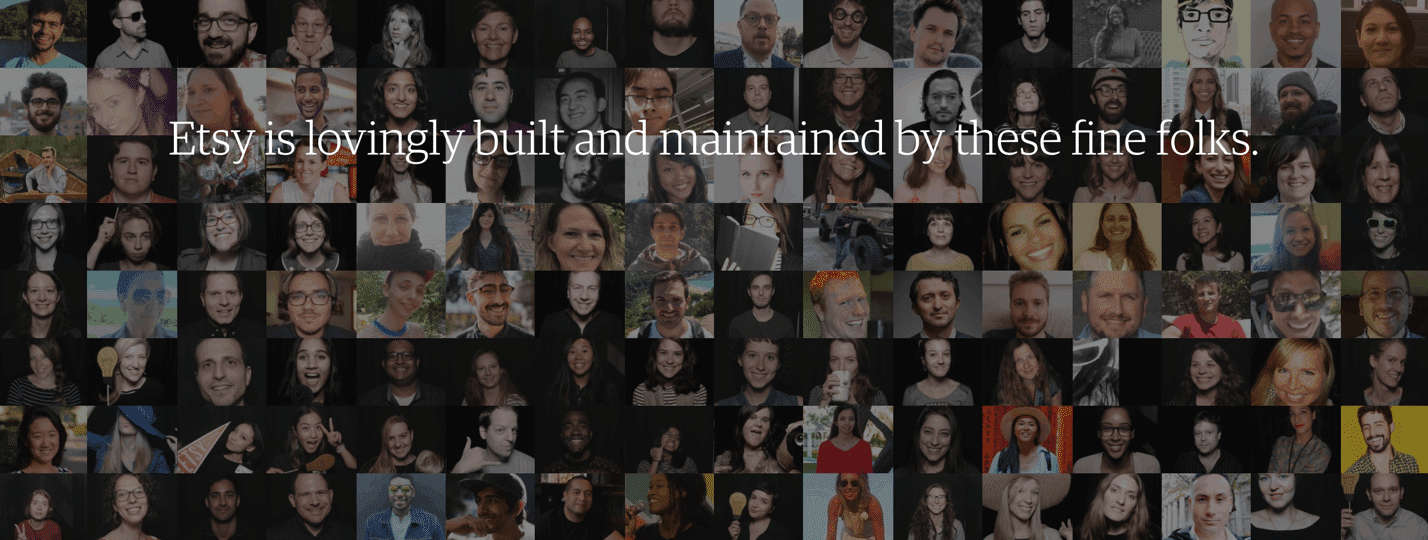
Online seller Etsy is a community made up of independent creators. For such a large and disparate organisation they’ve gone to the effort of highlighting all the many people who bring their site to life on their Team page.
It’s a lovely touch. One that reinforces the fact that customers are dealing with real people who are passionate about their craft(s).
Give your customers meaningful human interactions wherever possible to cement the relationship.
7. Offer exceptional customer service
What if we told you 100% of customer contacts represent an opportunity to ‘wow’ your customers?
The customer service your company provides can have a major bearing on customer trust and loyalty. That makes it crucial to hire dedicated support staff who are trained to a high standard.
Not only do they need a consistent framework to solve common customer bugbears but they also need to be given the freedom to treat every customer issue on an individual basis.
The aim here is to provide an efficient, professional and personable experience for your customers. If they feel like your team has gone above and beyond, then they’re far likelier to come back and then recommend you to their friends and family.
Global fitness technology company Peloton used to have a recurring issue with the standard of service provided by the third-party company that delivered their high-end stationary bikes.
“The delivery guys weren’t on time. They weren’t on brand. They didn’t educate customers on the product or the software,” said John Foley, Co-founder and CEO of Peloton, in an interview for PwC’s strategy+business magazine.
Foley brought deliveries in-house and now the company delivers 70% of their bikes themselves and has a customer satisfaction score of 5/5 for deliveries. Not bad, eh?!
Now, that’s how you tackle customer pain points head-on – and, in the process, offer excellent customer service. Take note!
If you’re struggling to deal with feedback on your own, and the action points it creates, there are a few ways forward: why not consider creating a self service option, where customers can use videos and content to resolve the issues you’re hearing about frequently?
Alternatively – and, of course, it’s another overhead – but you might think it worthwhile to hire customer service agents or bring on board a whole support team.
8. Build a reputation
Business magnate Warren Buffett once said, “It takes 20 years to build a reputation and five minutes to ruin it.”
Eek!
Like many a Buffett soundbite, those are wise words to bear in mind.
Consider how Facebook’s untouchable aura evaporated overnight following reports of their association with the British political consultants, Cambridge Analytica.
Or more recently Nike’s inextricable links to banned athletics coach Alberto Salazar who had managed their Nike Oregon Project for years.
The fates of these two huge corporations demonstrates that no organisation, however big or well-established, is immune to scandal and the resulting impact on customer trust.
The trick is to build a worthy reputation for doing things right. That includes supplying great products, providing faultless customer service and training your employees to the highest standards.
US consumer electronics retailer Best Buy recognised the need for nurturing a motivated workforce. They invested in digital tools for their sales team and introduced product training modules that employees could access via high-speed in-store bandwidth and within a designated training schedule.
According to PwC’s Global Consumer Insights Survey 2019, Best Buy staff also enjoy better than industry average discounts to encourage them to become ardent brand ambassadors.
Great customer experience starts and ends with motivated and well-trained employees. If your workforce is happy, chances are your customers will be too.
9. Share best practices
Who knows your product and industry better than anyone? That’s right: you do. Which is why you can earn some major brownie points with your customers by sharing handy tips and best practice about how to get the most out of your products.
This is the kind of gesture that doesn’t necessarily require a huge amount of your time or resources but actually delivers a whole lot of added value for your customers.
Sure, you’re promoting your products in a roundabout way but you’re also giving back valuable information to your customers who will no doubt appreciate your efforts and insights.
Explainer videos are great for sharing knowledge on a product.
Our research tells us that as many as 96% of people say they’ve watched an explainer video to learn more about a product or service, which tallies with the 96% of video marketers who say that video has helped to increase their customers’ understanding of their products or services.
This tutorial video from British DIY store B&Q gives detailed instructions about how to lay artificial grass. It delivers the double whammy of giving their customers useful tips, while plugging their products at the same time.
Give your customers extra by sharing hints and tips with no expectation of anything in return other than gratitude.
There’s a double bonus here – create content around your customer interests and you can also appeal to similar people who haven’t yet heard of your brand. This makes customer service content a potential vehicle for new customer discovery – how neat is that!
10. Be contactable
A business’ contact page is the touchpoint of interaction with their customers. For that very reason it’s guaranteed to be one of the most visited pages on any website.
In spite of this, however, many people overlook the significance and consequently the design and user experience of their contact page.
Improving the conversion rate of your contact page can benefit your business and providing a human touch to proceedings can help to convert ponderous purchasers into avid advocates.
It’s a great idea to provide as many avenues for connection as possible: phone numbers, your email address, social media handles and live chat functionality.
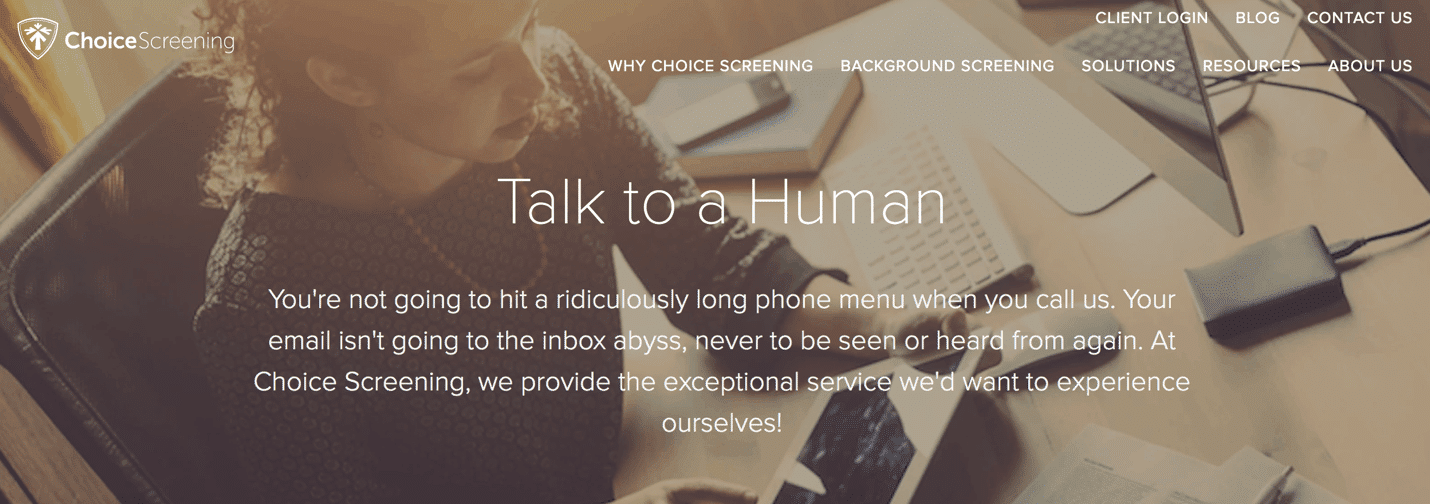
The logical starting point for optimising your conversions is to find the friction. Assess the data at your disposal to find the current benchmark for your contact forms. Where are you losing them? Why? What can you do to improve their experience?
Behaviour analytics software, like Hotjar, can give you insights into how real visitors interact with your site. This type of information can prove invaluable for improving the user experience. Tweak, test and refine constantly.
An in-depth study by HubSpot found that the sweet-spot for the number of form fields is three, which is a great indicator for keeping things simple for a frictionless user experience.
It doesn’t hurt to use a bit of humour and humility too, as Choice Screening prove (above). If you can bring the human touch to your communications, your customers will remember you for all the right reasons.
11. Build social proof
Just as customer reviews provide invaluable cues for building trust with prospective customers in a B2C setting, so do client references in the B2B world.
If your company has worked with some big-name clients – shout about it! If a household name has entrusted you with their reputation and you’ve delivered a great service in the process, that provides a huge amount of social proof and credibility for anyone seeking reassurance about your company.
Don’t be shy about leveraging the clout of past and present clients for some reflected glory. This is one of the easiest and most effective ways to build customer trust.

In order to get your point across, it’s a good idea to display the logos of your past clients (with their permission, of course!) prominently on your website.
Customer case studies are an effective way to take this method one step further, providing an in-depth synopsis of how your solutions helped a customer to overcome an issue and the results you were able to deliver. Think of these additions to your site as digital references.
“You’re only as good as your last success,” as they say; a mentality that definitely resonates with us at Wyzowl. Which is why we display our customers’ logos on our homepage, as well as testimonials and examples on our customers page.
Shout about your successes to reassure potential customers you’re the real deal.
12. Respond to customer feedback
It’s a bit of a cliche but – like most relationships – the best customer relationships are truly a two-way street. One of the most effective ways to build trust with your customers is simply to ‘listen’: take on board, and respond positively, to customer feedback.
Many tried and tested experts would say it’s impossible to build a successful business without enabling, empowering and responding positively to customer feedback.
Inviting feedback in the first place shows that you’re invested in the customer experience, care about their best interests, and are passionate about delivering the best possible experience.
And the way you respond to that feedback is every bit as important. Being positive in the face of criticism, putting your ego to one side and trying to understand the root issue, and working hard to fix it? Offering product support and personal recommendations, rather than cookie-cutter responses? That’s priceless, and ensures customers feel heard.
For bonus points, schedule follow ups: go back to your customers a month or two later, and actually check that their issue is resolved. This proactive approach goes beyond what you ‘say’ and strikes at the heart of what you ‘do.’ It deeply demonstrates a commitment to caring about your customer – and THAT is the sort of experience that builds trust, loyalty and respect.
13. Offer loyalty programs
Ok, so we’re talking about building customer trust here, not necessarily loyalty. But this is a real chicken-and-egg situation: trust is a driver of loyalty, but loyalty helps develop trust.
How so? Well, think for a second about the optics of a loyalty program – what it says about you as a business. Frankly, it says you’re somebody who cares about long-term relationships with your customers, to the point of being willing to incentivise repeat business.
There’s an obvious, deep commercial incentive here: studies suggest that 65% of a company’s business comes from existing customers, and 75% of customers say they favour companies that offer rewards.
But when you’re trying to earn customer trust – win that sale, get that purchase over the line, beat out your competitors – the optics of a customer loyalty program can be the deciding factor, invoking the idea of a long-term, symbiotic relationship which rewards both parties.
Take E.l.f ‘s tiered loyalty scheme, for example. Every customer is automatically enrolled, with points awarded for purchases. The more you spend, the higher your level of reward.
The takeaway for someone seeing this? It may not be articulated so directly, but you’d think it would be: “This is a company I’m going to be comfortable buying from repeatedly, and in doing so, I can clearly see that I’ll be rewarded.” Clearly, this is a key driver of trust.
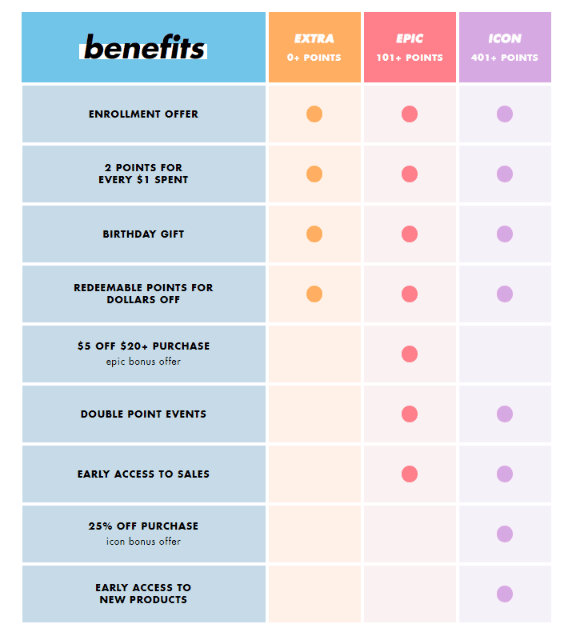
Summary
Trust is the glue that bonds a customer to a brand. Businesses that know how to build customer trust and nurture a long-term relationship with them are likely to reap the rewards.
There are no shortcuts or secrets to fostering customer trust. It’s pretty simple: make your customers your top priority at all times.
Give them excellent products. Deliver responsive and personalised customer service. Be honest, transparent and authentic. And communicate effectively – face-to-face, across all forms of correspondence, and through your brand ambassadors. Fine tune your offering at all times. That’s how to build customer trust, and – in the process – develop strong customer loyalty.
Following these logical steps is your fast-track to securing a fiercely loyal fandom and boosting your sales in the process – turning ‘customers’ into ‘long-term’ customers!
Now you know how to gain customer trust and confidence, why not put some of our advice into action by checking out these tips on how to create a powerful testimonial video that converts.

